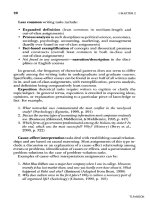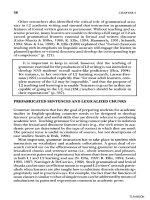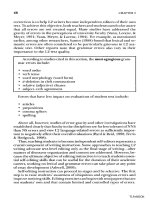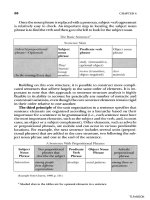Improving learners' academic IELTS writing performance through modeling
Bạn đang xem bản rút gọn của tài liệu. Xem và tải ngay bản đầy đủ của tài liệu tại đây (133.22 KB, 4 trang )
Improving learners' academic IELTS writing
performance through modeling
Nâng cao kha
̉
năng viết IELTS ho
̣
c thuâ
̣
t cho
hc viên qua vic gii thiu bi mu
Đon Thị Hương
University of Languages and International Studies
M.A. Thesis. English Teaching Methodology; Mã số: 60 14 10
Supervisor : M.A. Lâm Thi
̣
Phu
́
c Hân
Năm bảo v: 2012
Abstract. A challenge for English teachers working on EAP or IELTS preparation course
is to find methods to teach writing in general and essay writing in particular more
efficiently and effectively. The purpose of this study is to investigate the difficulties in
learning IELTS writing, to explore the role of model texts (sample texts) as a source of
teaching tool, and learners and teachers’ opinions about the use of model texts in a
writing class. In order to achieve the aims, three data collection instruments, namely
survey questionnaire, tests, and interview, were employed with the participants of thirty
learners studying in a preparation course and four teachers at London Foreign Language
Centre. The results showed that the learners had to face many difficulties in learning
IELTS writing skills and model texts did bear a significant impact on the writing
improvement of the learners. In addition, all the interviewees expressed their satisfactions
with the use of model texts.
Keywords. Ngôn ngữ; Tiếng Anh; Kỹ năng viết; Phương pháp giảng dạy
Content.
The study is divided into three parts. The first part is the introduction dealing with
the rationale, aims, scope, significance, methods and organization of the study.
The second part is the main part of the paper with three chapters.
Chapter 1: provides the background for the study, including a review on key concepts
relating to the research topic. This chapter also briefly discusses the literature in the field
to reveal the research gap that needs to be filled.
Chapter 2: present the research methods adopted in the study. Justifications of the chosen
research instruments as well as their implementation are also provided.
Chapter 3: reveals the results of the study and the discussions of the results.
The last part is the conclusion that summarizes the major findings of the study.
This chapter also gives recommendations to both learners and teachers in order to
improve the learning and teaching IELTS writing skills. Besides, some limitation of the
study and suggestions for further studies are put forward. Following this part are the
Appendices and References.
References.
1. Abe, M. (2008). Exploring the role of model essays in the IELTS writing Test: A
feedback tool. Retrieved December 2011 from an-efl
journal.com/Thesis_M_Abe.pdf.
2. Atkinson, D., & Ramanathan, V. (1995). Cultures of writing: An ethnographic
comparison of L1 and L2 university writing/ language programs. TESOL Quarterly, 29,
539-568.
3. Badger, R. and G.White (2000). A process genre approach to teaching writing. EFL
Journal, 54 (2), 153-160.
4. Bagheri, M & Zare, M (2009). The Role of Using IELTS Model Essays in Improving
learners’ Writing and their Awareness of Writing Features. JELTS, 1 (1), 115-130.
Retrieved January 2012 from http: www.sid.ir/en/VEWSSID/J_pdf/1032120090107.pdf
5. Boughey, C. (1997). Learning to write by writing to learn: a group- work approach,
ELT Journal, 51(2), 126-134.
6. Charney, D. H., & Carlson, R. A. (1995). Learning to write in a genre: what student
writers take from model texts. Research in the Teaching of English, 29 (1), 88-122.
7. David C. Hughes (1999). The use of model essays to reduce context effects in essay
scoring. Retrieved on April 15, 2012 from
8. Harris, J. (1993). Introducing Writing. London: Penguin English.
9. Hedge, T. (1988). Writing. Resource Books for Teachers. Oxford University Press.
11. Huong, T. (2010). Exploiting Model Essays in Teaching IELTS Writing to Students in
Foundation Studies Department of Hanoi University. M.A thesis, Vietnam National
University, Hanoi, Vietnam
12. Lougheed, L. (2006). Barron’s IELTS. Barron’s Educational Series, Inc. Hauppauge,
NY11788, USA.
13. Martin, J. R. (1989). Factual Writing: Exploring and Challenging Social Reality.
Oxford: Oxford University Press.
14. Miller, C. (1984). Genre as social action. Quarterly Journal Speech, 70, 151-167
15. Nunan, D. (1991). Language Teaching Methodology: A Textbook for Teachers.
Sydney: Macquarie University.
16. O’Sullian, K & Lindeck, J. Focusing on IELTS: Reading and Writing Skills.
Cambridge: Cambridge University Press.
17. Qi, D.S., & Lapkin, S. (2001). Exploring the role of noticing in a three-stage second
language writing task. Journal of Second Language Writing, 10, 277-303.
18. Raimes, A. (1991). Out of woods: Traditions in the teaching of writing. TESOL
Quarterly, 25, 407-430.
19. Raimes, A. (1998). Teaching writing. Annual Review of Applied Linguistics, 18, 142-
167.
20. Ransell, D. R. (1993). Creative writing is Greek to me: The continuing education of a
language teacher, ELT Journal, 47 (1), 40-60.
21. Sahebkheir, K. (2011). The Effect of Model Essays on Developing Accuracy and
Complexity of EFL Learners’ Writing in the Iranian Context. Retrieved on February 24,
2012 from
22. Slater, S. (2009). Use Model Essays for Your Benefits. Retrieved on March 10, 2012
from />ultimately-be-useful.
23. Stolarek, E. (1994). Prose modeling and metacognition: The effect of modeling on
developing a metacognitive stance toward writing. Research in the Teaching of English,
28,154-174
24. Tribble,C.(1996). Writing. Oxford: Oxford Universiy Press.
UCLES (2007). International English Language Testing System. Retrieved on April 8, 2012
from
25. Uysal, H.H. (2010). A critical review of the IELTS writing test. ELT Journal, 64 (3).
314-320.
26. Watson, C. B. (1982). The use and abuse of models in the ESL writing class. TESOL
Quarterly, 16 (1), 5-13.
27. Wu, C. C. (2002). A case study of the rhetorical analysis via expository models on
Taiwanese freshmen’s English compositions. M.A thesis, National Tsing Hua University,
Hinchu, Taiwan.









